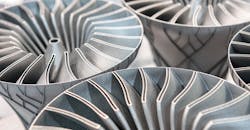3D printing is growing to a new level of importance in manufacturing, with research showing the various process for additive technology are no longer being used solely for prototyping: Additive manufacturing/3DP now is used for production parts, bridge production, and repair, among many other mission-critical manufacturing functions. Modern 3D printers’ ability to print with common alloys such as aluminum and titanium have made the technology fit for even the most demanding industrial production jobs.
As 3DP's popularity and applications continue to grow, manufacturers seeking to adopt the technology must ensure that any 3D printers can work in harmony with the rest of their hardware, software, and supporting technologies already deployed.
Needs to succeed: ERP and DDMRP. From a manufacturing approach and supporting software perspective, 3D printing is not vastly different from traditional manufacturing technologies. The production process consists of multiple steps, which means relying on two different types of machines to complete an entire part and scheduling human resources to do the machining — with effective planning also required to manage buffer capacity in the number of printers.
This demands an enterprise resource planning (ERP) system capable of handling additive manufacturing operations with Demand-Driven Materials Requirements Planning (DDMRP) functionality, to ensure high profitability without having to turn away orders during peak periods. When DDMRP capability is embedded in ERP, it can help manufacturers prepare for demand shocks with strategic buffer inventories of specific materials—leading to five significant benefits to productivity.
1. Faster parts production, if bottlenecks are overcome. Using 3D printing, manufacturers can produce parts that would be difficult or expensive to manufacture using standard forming, fabricating, and or subtractive manufacturing methods, primarily because additive manufacturing allows for designs to be less constrained by manufacturability. To make the AM/3DP process faster and more efficient, manufacturers need to make use of DDMRP to plan around bottlenecks and constraints in the process. ERP must plan production around the low-volume constraints of 3D-printing machinery, and plan inventory of materials based on the demand plan.
It should be simple and intuitive to schedule steps in the 3D printing of production parts. Because one significant bottleneck will be the 3D printing unit itself, it is crucial to determine how many of these machines a facility needs – given a balance of demand and required utilization rate – to achieve ROI.
2: Optimized workflow with refined production sequencing. With properly defined workflows in the ERP system, manufacturers can optimize scheduling and sequencing to achieve the fastest turn times and best part availability. They need to sequence parts based on certain characteristics so they can go through the printing and subsequent processes as quickly and inexpensively as possible.
Optimal production sequencing gets the right parts into each step of production at the right time for faster turn times. When work is handed off directly from one workstation to the next smoothly – not allowing parts to linger as ‘work in progress’ – manufacturers can gain a real competitive edge in their markets.
3. Streamlined spares and repairs, reduced waste. 3D printing can significantly streamline the "spares and repairs" inventory, enabling manufacturers to focus efforts on maintaining their own assets, manufacture engineer-to-order products and support customers in aftermarket service contracts—a move into new revenue streams which offers further growth potential.
It is also an appealing technology to manufacturers looking to cut back on waste. In traditional manufacturing, part production often involves machining or deburring, or surface finishing, to get a part to its specified status — creating excess material that is mostly unusable. But, as 3D printing is an additive process – producing a discrete item or part – material removed during machining may be reground and used over again.
4. Digital twins for future-proof production. 3D printing has benefits manufacturers can count on long into the future. Even if an organization does not use additive manufacturing for production parts, there is still substantial benefit to the iterative design process.
A company using 3D printing by default has a digital twin of each part, without having to go through a separate process to create it. In theory, an industrial manufacturer should be able to assemble a digital maintenance model and use it to support a product such as a piece of machinery over its entire lifecycle.
5. Quality control. Many manufacturers rely on annual service contracts with equipment vendors to handle inspection and re-calibration. With 3D printing, quality problems usually are a result of miscalibration of the machine, e.g., in terms of process temperature, nozzle size, or speed.
Manufacturers must make sure they have the software tools to support a condition-based maintenance program or the contract management tools to proactively manage deliverables against a service-based contract. ERP can provide visibility and traceability into the service process to keep 3D printers operational.
A fitting solution across industries. Due to the capital expense of the hardware, it is important to have a solid business case for engaging in 3D printing for production. Some of the best returns come in mission-critical environments, including aerospace and defense and medical device manufacturing. From hip replacements to turbine blades for jet engines, 3D printing is increasingly common.
With a reasonable number of 3D printers, a strong business case and the right supporting software, manufacturers can unlock business value in design flexibility and lead times. Integrating additive manufacturing with ERP and DDMRP functionality into operations this way will help manufacturers to optimize industrial operations, keep customers and stakeholders happy, and disrupt the market.
Bill Leedale is a senior advisor to IFS in North America. IFS is an enterprise software solution provider, developing and supplying ERP, EAM, FSM and ESM to businesses worldwide. Contact him via LinkedIn.About the Author
Bill Leedale
Senior Advisor
Bill Leedale is a senior advisor to IFS in North America. IFS is an enterprise software solution provider, developing and supplying ERP, EAM, FSM and ESM to businesses worldwide. Contact him via LinkedIn.
